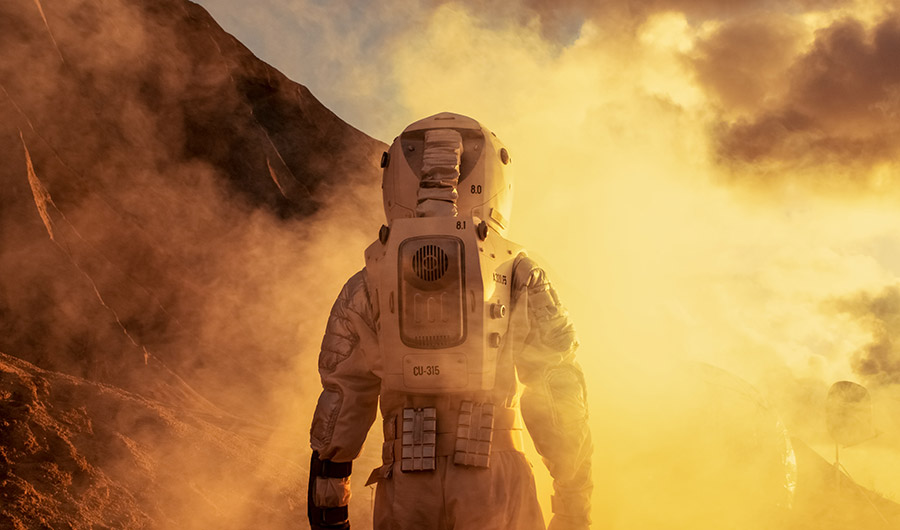Mouse Study Raises Concerns About Human Brain Function During Space Travel

Gorodenkoff/shutterstock
(Inside Science) -- Next summer, NASA will launch its fifth rover to Mars to look for signs of ancient life on the Red Planet. But the latest robotic mission, simply dubbed Mars 2020, has another goal: figuring out how to sustain human life in the harsh and unforgiving environment on Mars. Hitching a ride on the rover are devices to convert the abundant carbon dioxide on Mars into oxygen and a ground-penetrating radar to hunt for underground ice as a future water supply.
But even before the first astronauts set foot on the dry, barren Martian wasteland, the long journey itself could jeopardize their health. Any future astronaut headed to Mars will be exposed to harmful ionizing cosmic radiation during the entire trip, which could last a year or more.
While the increase in cancer risk due to radiation is relatively well understood, a new study in mice reveals that space radiation may also lead to disruptions in brain activity and significant cognitive impairment. The results, published this week in the journal eNeuro, suggest that chronic, low dose rate radiation exposure from deep space travel may pose considerable risks for astronauts' cognitive performance and health.
The shielding of spacecraft can protect humans from one of the two types of radiation that they will encounter, created by solar particle events, but it can't fully protect against galactic cosmic rays from outside our solar system. When the latter collide with the shielding material of a spacecraft, they can knock apart atoms and shower the astronauts inside with what's called secondary radiation. The researchers used a new neutron irradiation facility to mimic the prolonged risks of secondary radiation during an interplanetary voyage.
"Prior work, for a variety of reasons, has used radiation delivered at dose rates approximately 400 times those found in space," said senior author Charles Limoli, a radiation oncologist at the University of California, Irvine. "This study is the first to document the adverse effects of more realistic dose rate simulations of the deep space radiation environment."
Other researchers are skeptical of the approach. Francis Cucinotta, a health physicist at the University of Nevada, Las Vegas, argued that the study has "almost no relevance for space missions to the Moon or Mars." First, he disputes the authors' claim that the neutron radiation in the experiment is space-relevant. Cucinotta also noted that the experiment used the most damaging energy of neutrons known, which he said differs from the kind of radiation astronauts would actually encounter.
"There is no way an astronaut would be exposed to this neutron energy source or the equivalent dose used," said Cucinotta.
Jeff Chancellor, a physicist at Louisiana State University in Baton Rouge, appreciated that the researchers took the time and effort to approach a more realistic analogue for the low dose rate encountered during space travel than previous studies. But he also had an issue with the use of neutrons as a radiation source. "They are claiming that these fast neutrons are a viable surrogate because it's a low dose, but it's still not the same."
Limoli's experiment housed 40 mice in the facility for six months and exposed them to radiation at a rate of 1 milligray per day, which approximates the average dose encountered during deep space travel. Control mice were kept in a separate area and received no irradiation.
The researchers observed that the radiation exposure impaired both the hippocampus, a structure in the brain tied to learning and memory, and the medial prefrontal cortex, which plays a role in higher cognitive functions. Also, electrophysiological recordings showed disturbances in the activity of individual neurons and normal brain processes revealed differences in the mice's overall behavior. Those exposed to radiation performed poorly on learning and memory tests compared to the control mice, and also showed more signs of anxious and antisocial tendencies.
Limoli believes that their work fairly represents the neutron radiation exposure that astronauts would face on a long trip. "We have modeled this extensively," he wrote in an email. The total dose would include neutron radiation produced by the interaction of galactic cosmic rays and the planet's surface, all spacecraft components, and the body of the astronaut, he added.
"It’s an elegant study, and their results are very interesting -- but I don't agree that neutrons are a feasible surrogate for the [galactic cosmic ray] environment," said Chancellor.
"There are about 180 cosmonauts and astronauts who have been exposed to these levels of radiation, and they have never had these health outcomes," said Chancellor. "My wife [American astronaut Serena Auñón-Chancellor], probably got the same dose, and she's the same person she always was. In fact, there's never been a clinical diagnosis in a human due to a space radiation exposure."
From their calculations, Limoli and his colleagues predict that 1 in every 5.1 astronauts would experience anxiety-like behavior during a mission to Mars, and 1 in every 2.8 astronauts would experience memory problems.
